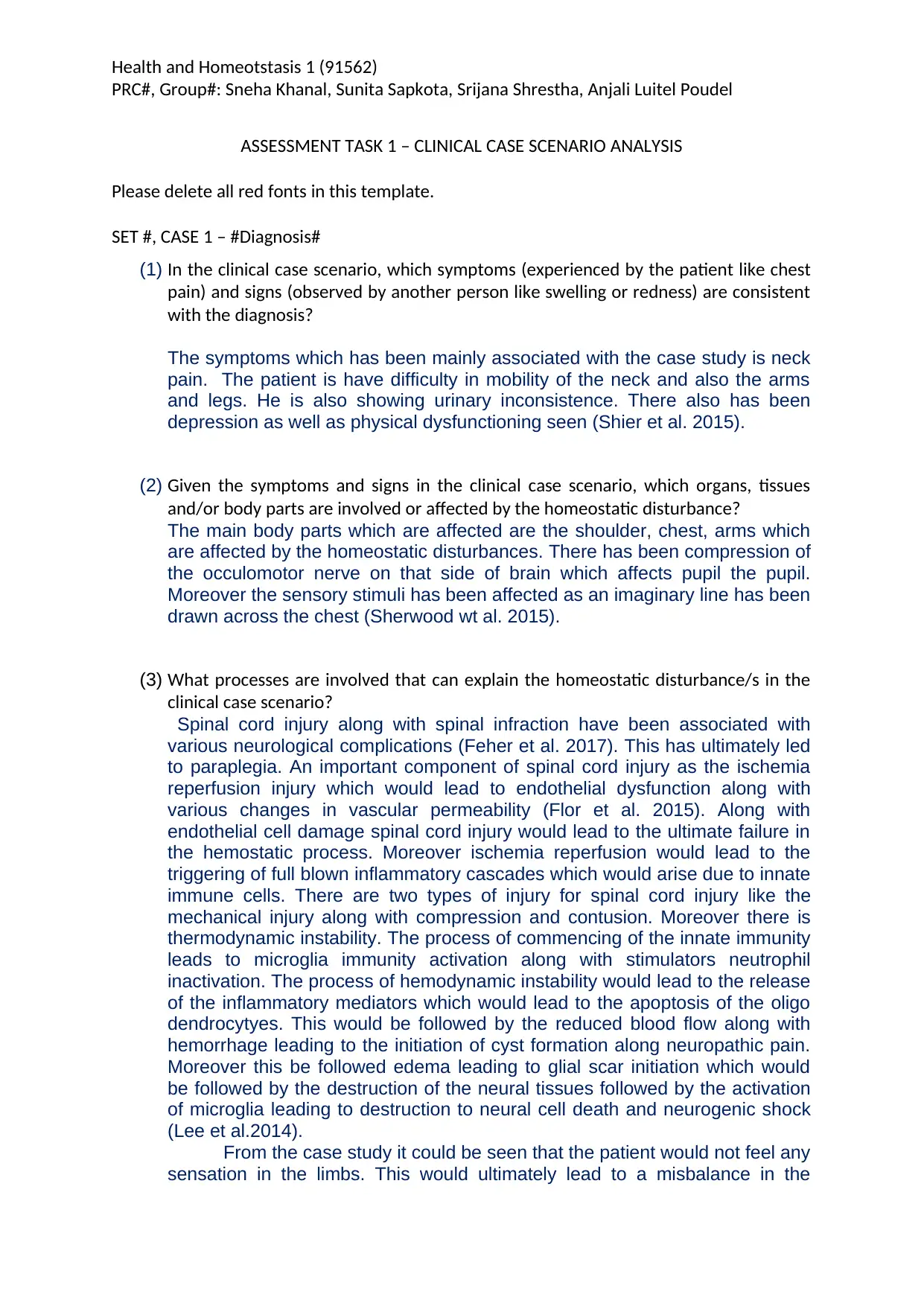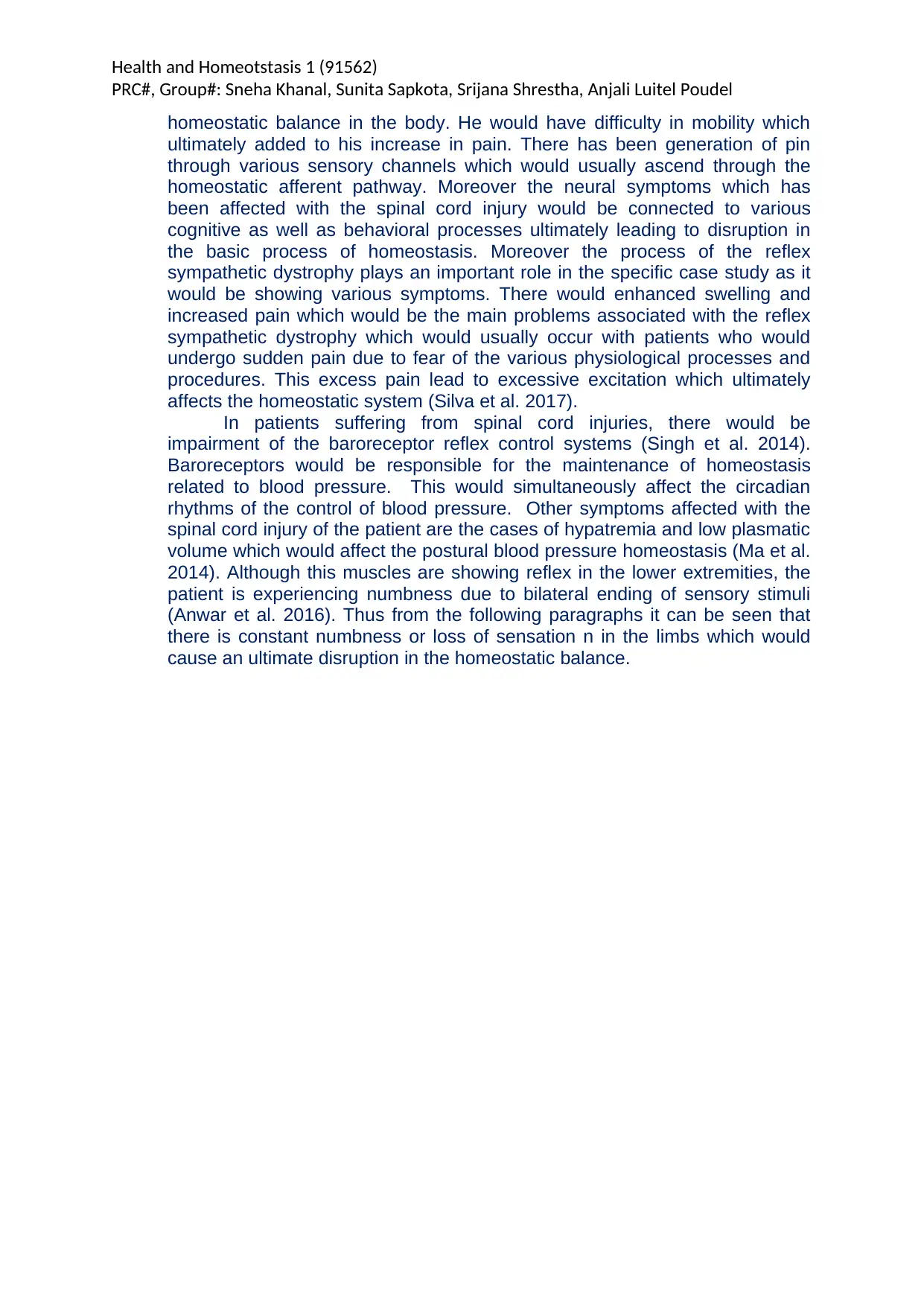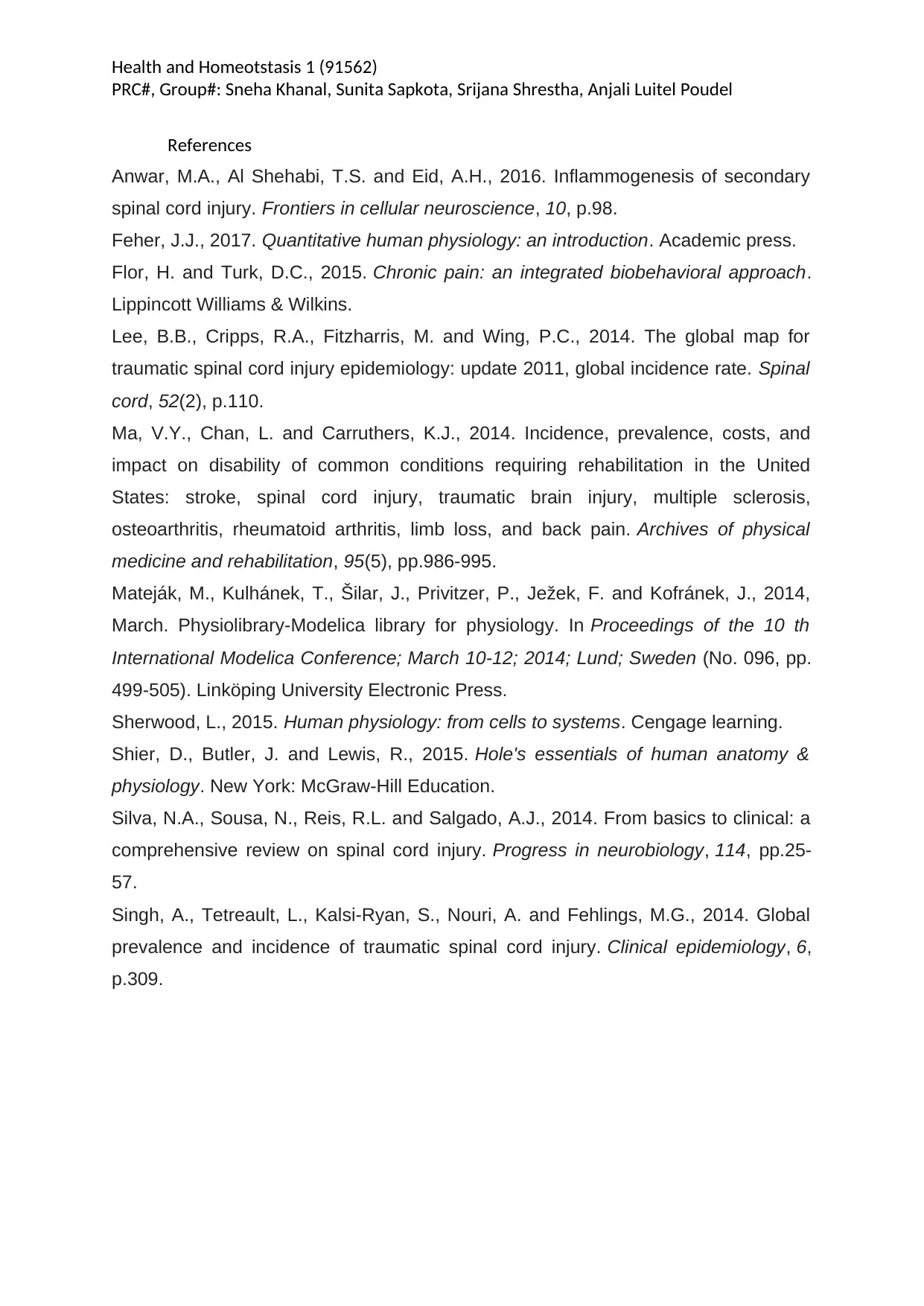Health and Homeostasis 1 (91562)
VerifiedAdded on 2023/04/03
|3
|1035
|213
AI Summary
This document discusses a clinical case scenario analysis of a patient with a homeostatic disturbance. It explores the symptoms, organs affected, and processes involved in the disturbance. The document also includes references for further reading.
Contribute Materials
Your contribution can guide someone’s learning journey. Share your
documents today.

Health and Homeotstasis 1 (91562)
PRC#, Group#: Sneha Khanal, Sunita Sapkota, Srijana Shrestha, Anjali Luitel Poudel
ASSESSMENT TASK 1 – CLINICAL CASE SCENARIO ANALYSIS
Please delete all red fonts in this template.
SET #, CASE 1 – #Diagnosis#
(1) In the clinical case scenario, which symptoms (experienced by the patient like chest
pain) and signs (observed by another person like swelling or redness) are consistent
with the diagnosis?
The symptoms which has been mainly associated with the case study is neck
pain. The patient is have difficulty in mobility of the neck and also the arms
and legs. He is also showing urinary inconsistence. There also has been
depression as well as physical dysfunctioning seen (Shier et al. 2015).
(2) Given the symptoms and signs in the clinical case scenario, which organs, tissues
and/or body parts are involved or affected by the homeostatic disturbance?
The main body parts which are affected are the shoulder, chest, arms which
are affected by the homeostatic disturbances. There has been compression of
the occulomotor nerve on that side of brain which affects pupil the pupil.
Moreover the sensory stimuli has been affected as an imaginary line has been
drawn across the chest (Sherwood wt al. 2015).
(3) What processes are involved that can explain the homeostatic disturbance/s in the
clinical case scenario?
Spinal cord injury along with spinal infraction have been associated with
various neurological complications (Feher et al. 2017). This has ultimately led
to paraplegia. An important component of spinal cord injury as the ischemia
reperfusion injury which would lead to endothelial dysfunction along with
various changes in vascular permeability (Flor et al. 2015). Along with
endothelial cell damage spinal cord injury would lead to the ultimate failure in
the hemostatic process. Moreover ischemia reperfusion would lead to the
triggering of full blown inflammatory cascades which would arise due to innate
immune cells. There are two types of injury for spinal cord injury like the
mechanical injury along with compression and contusion. Moreover there is
thermodynamic instability. The process of commencing of the innate immunity
leads to microglia immunity activation along with stimulators neutrophil
inactivation. The process of hemodynamic instability would lead to the release
of the inflammatory mediators which would lead to the apoptosis of the oligo
dendrocytyes. This would be followed by the reduced blood flow along with
hemorrhage leading to the initiation of cyst formation along neuropathic pain.
Moreover this be followed edema leading to glial scar initiation which would
be followed by the destruction of the neural tissues followed by the activation
of microglia leading to destruction to neural cell death and neurogenic shock
(Lee et al.2014).
From the case study it could be seen that the patient would not feel any
sensation in the limbs. This would ultimately lead to a misbalance in the
PRC#, Group#: Sneha Khanal, Sunita Sapkota, Srijana Shrestha, Anjali Luitel Poudel
ASSESSMENT TASK 1 – CLINICAL CASE SCENARIO ANALYSIS
Please delete all red fonts in this template.
SET #, CASE 1 – #Diagnosis#
(1) In the clinical case scenario, which symptoms (experienced by the patient like chest
pain) and signs (observed by another person like swelling or redness) are consistent
with the diagnosis?
The symptoms which has been mainly associated with the case study is neck
pain. The patient is have difficulty in mobility of the neck and also the arms
and legs. He is also showing urinary inconsistence. There also has been
depression as well as physical dysfunctioning seen (Shier et al. 2015).
(2) Given the symptoms and signs in the clinical case scenario, which organs, tissues
and/or body parts are involved or affected by the homeostatic disturbance?
The main body parts which are affected are the shoulder, chest, arms which
are affected by the homeostatic disturbances. There has been compression of
the occulomotor nerve on that side of brain which affects pupil the pupil.
Moreover the sensory stimuli has been affected as an imaginary line has been
drawn across the chest (Sherwood wt al. 2015).
(3) What processes are involved that can explain the homeostatic disturbance/s in the
clinical case scenario?
Spinal cord injury along with spinal infraction have been associated with
various neurological complications (Feher et al. 2017). This has ultimately led
to paraplegia. An important component of spinal cord injury as the ischemia
reperfusion injury which would lead to endothelial dysfunction along with
various changes in vascular permeability (Flor et al. 2015). Along with
endothelial cell damage spinal cord injury would lead to the ultimate failure in
the hemostatic process. Moreover ischemia reperfusion would lead to the
triggering of full blown inflammatory cascades which would arise due to innate
immune cells. There are two types of injury for spinal cord injury like the
mechanical injury along with compression and contusion. Moreover there is
thermodynamic instability. The process of commencing of the innate immunity
leads to microglia immunity activation along with stimulators neutrophil
inactivation. The process of hemodynamic instability would lead to the release
of the inflammatory mediators which would lead to the apoptosis of the oligo
dendrocytyes. This would be followed by the reduced blood flow along with
hemorrhage leading to the initiation of cyst formation along neuropathic pain.
Moreover this be followed edema leading to glial scar initiation which would
be followed by the destruction of the neural tissues followed by the activation
of microglia leading to destruction to neural cell death and neurogenic shock
(Lee et al.2014).
From the case study it could be seen that the patient would not feel any
sensation in the limbs. This would ultimately lead to a misbalance in the
Secure Best Marks with AI Grader
Need help grading? Try our AI Grader for instant feedback on your assignments.

Health and Homeotstasis 1 (91562)
PRC#, Group#: Sneha Khanal, Sunita Sapkota, Srijana Shrestha, Anjali Luitel Poudel
homeostatic balance in the body. He would have difficulty in mobility which
ultimately added to his increase in pain. There has been generation of pin
through various sensory channels which would usually ascend through the
homeostatic afferent pathway. Moreover the neural symptoms which has
been affected with the spinal cord injury would be connected to various
cognitive as well as behavioral processes ultimately leading to disruption in
the basic process of homeostasis. Moreover the process of the reflex
sympathetic dystrophy plays an important role in the specific case study as it
would be showing various symptoms. There would enhanced swelling and
increased pain which would be the main problems associated with the reflex
sympathetic dystrophy which would usually occur with patients who would
undergo sudden pain due to fear of the various physiological processes and
procedures. This excess pain lead to excessive excitation which ultimately
affects the homeostatic system (Silva et al. 2017).
In patients suffering from spinal cord injuries, there would be
impairment of the baroreceptor reflex control systems (Singh et al. 2014).
Baroreceptors would be responsible for the maintenance of homeostasis
related to blood pressure. This would simultaneously affect the circadian
rhythms of the control of blood pressure. Other symptoms affected with the
spinal cord injury of the patient are the cases of hypatremia and low plasmatic
volume which would affect the postural blood pressure homeostasis (Ma et al.
2014). Although this muscles are showing reflex in the lower extremities, the
patient is experiencing numbness due to bilateral ending of sensory stimuli
(Anwar et al. 2016). Thus from the following paragraphs it can be seen that
there is constant numbness or loss of sensation n in the limbs which would
cause an ultimate disruption in the homeostatic balance.
PRC#, Group#: Sneha Khanal, Sunita Sapkota, Srijana Shrestha, Anjali Luitel Poudel
homeostatic balance in the body. He would have difficulty in mobility which
ultimately added to his increase in pain. There has been generation of pin
through various sensory channels which would usually ascend through the
homeostatic afferent pathway. Moreover the neural symptoms which has
been affected with the spinal cord injury would be connected to various
cognitive as well as behavioral processes ultimately leading to disruption in
the basic process of homeostasis. Moreover the process of the reflex
sympathetic dystrophy plays an important role in the specific case study as it
would be showing various symptoms. There would enhanced swelling and
increased pain which would be the main problems associated with the reflex
sympathetic dystrophy which would usually occur with patients who would
undergo sudden pain due to fear of the various physiological processes and
procedures. This excess pain lead to excessive excitation which ultimately
affects the homeostatic system (Silva et al. 2017).
In patients suffering from spinal cord injuries, there would be
impairment of the baroreceptor reflex control systems (Singh et al. 2014).
Baroreceptors would be responsible for the maintenance of homeostasis
related to blood pressure. This would simultaneously affect the circadian
rhythms of the control of blood pressure. Other symptoms affected with the
spinal cord injury of the patient are the cases of hypatremia and low plasmatic
volume which would affect the postural blood pressure homeostasis (Ma et al.
2014). Although this muscles are showing reflex in the lower extremities, the
patient is experiencing numbness due to bilateral ending of sensory stimuli
(Anwar et al. 2016). Thus from the following paragraphs it can be seen that
there is constant numbness or loss of sensation n in the limbs which would
cause an ultimate disruption in the homeostatic balance.

Health and Homeotstasis 1 (91562)
PRC#, Group#: Sneha Khanal, Sunita Sapkota, Srijana Shrestha, Anjali Luitel Poudel
References
Anwar, M.A., Al Shehabi, T.S. and Eid, A.H., 2016. Inflammogenesis of secondary
spinal cord injury. Frontiers in cellular neuroscience, 10, p.98.
Feher, J.J., 2017. Quantitative human physiology: an introduction. Academic press.
Flor, H. and Turk, D.C., 2015. Chronic pain: an integrated biobehavioral approach.
Lippincott Williams & Wilkins.
Lee, B.B., Cripps, R.A., Fitzharris, M. and Wing, P.C., 2014. The global map for
traumatic spinal cord injury epidemiology: update 2011, global incidence rate. Spinal
cord, 52(2), p.110.
Ma, V.Y., Chan, L. and Carruthers, K.J., 2014. Incidence, prevalence, costs, and
impact on disability of common conditions requiring rehabilitation in the United
States: stroke, spinal cord injury, traumatic brain injury, multiple sclerosis,
osteoarthritis, rheumatoid arthritis, limb loss, and back pain. Archives of physical
medicine and rehabilitation, 95(5), pp.986-995.
Mateják, M., Kulhánek, T., Šilar, J., Privitzer, P., Ježek, F. and Kofránek, J., 2014,
March. Physiolibrary-Modelica library for physiology. In Proceedings of the 10 th
International Modelica Conference; March 10-12; 2014; Lund; Sweden (No. 096, pp.
499-505). Linköping University Electronic Press.
Sherwood, L., 2015. Human physiology: from cells to systems. Cengage learning.
Shier, D., Butler, J. and Lewis, R., 2015. Hole's essentials of human anatomy &
physiology. New York: McGraw-Hill Education.
Silva, N.A., Sousa, N., Reis, R.L. and Salgado, A.J., 2014. From basics to clinical: a
comprehensive review on spinal cord injury. Progress in neurobiology, 114, pp.25-
57.
Singh, A., Tetreault, L., Kalsi-Ryan, S., Nouri, A. and Fehlings, M.G., 2014. Global
prevalence and incidence of traumatic spinal cord injury. Clinical epidemiology, 6,
p.309.
PRC#, Group#: Sneha Khanal, Sunita Sapkota, Srijana Shrestha, Anjali Luitel Poudel
References
Anwar, M.A., Al Shehabi, T.S. and Eid, A.H., 2016. Inflammogenesis of secondary
spinal cord injury. Frontiers in cellular neuroscience, 10, p.98.
Feher, J.J., 2017. Quantitative human physiology: an introduction. Academic press.
Flor, H. and Turk, D.C., 2015. Chronic pain: an integrated biobehavioral approach.
Lippincott Williams & Wilkins.
Lee, B.B., Cripps, R.A., Fitzharris, M. and Wing, P.C., 2014. The global map for
traumatic spinal cord injury epidemiology: update 2011, global incidence rate. Spinal
cord, 52(2), p.110.
Ma, V.Y., Chan, L. and Carruthers, K.J., 2014. Incidence, prevalence, costs, and
impact on disability of common conditions requiring rehabilitation in the United
States: stroke, spinal cord injury, traumatic brain injury, multiple sclerosis,
osteoarthritis, rheumatoid arthritis, limb loss, and back pain. Archives of physical
medicine and rehabilitation, 95(5), pp.986-995.
Mateják, M., Kulhánek, T., Šilar, J., Privitzer, P., Ježek, F. and Kofránek, J., 2014,
March. Physiolibrary-Modelica library for physiology. In Proceedings of the 10 th
International Modelica Conference; March 10-12; 2014; Lund; Sweden (No. 096, pp.
499-505). Linköping University Electronic Press.
Sherwood, L., 2015. Human physiology: from cells to systems. Cengage learning.
Shier, D., Butler, J. and Lewis, R., 2015. Hole's essentials of human anatomy &
physiology. New York: McGraw-Hill Education.
Silva, N.A., Sousa, N., Reis, R.L. and Salgado, A.J., 2014. From basics to clinical: a
comprehensive review on spinal cord injury. Progress in neurobiology, 114, pp.25-
57.
Singh, A., Tetreault, L., Kalsi-Ryan, S., Nouri, A. and Fehlings, M.G., 2014. Global
prevalence and incidence of traumatic spinal cord injury. Clinical epidemiology, 6,
p.309.
1 out of 3
Your All-in-One AI-Powered Toolkit for Academic Success.
+13062052269
info@desklib.com
Available 24*7 on WhatsApp / Email
![[object Object]](/_next/static/media/star-bottom.7253800d.svg)
Unlock your academic potential
© 2024 | Zucol Services PVT LTD | All rights reserved.
